Applications of LIF to Document Natural Variability of Chlorophyll Content and Cu Uptake in Moss
Abstract
1. Introduction
2. Results
2.1. Comparison of LIF Technique to Moss Fronds
2.2. Comparison of LIF Analysis of Chl-SL and SET Fronds
2.3. Chlorophyll Extraction and SET Results
2.4. Optimal Imaging Methods Applied to Chlorophyll Extraction Fluid
3. Discussion
4. Materials and Methods
4.1. Laboratory Procedure
4.2. Laser Systems and LIF Imaging Technique
4.3. Chemical Analysis
4.3.1. Sequential Elution Technique (SET)
4.3.2. Chlorophyll Extraction Method
4.4. Data Analysis
4.4.1. Image Preprocessing
4.4.2. Single-Color Comparison
4.4.3. Multi-Color Comparison
5. Conclusions
Author Contributions
Funding
Data Availability Statement
Conflicts of Interest
Appendix A
References
- Bates, J.W. Mineral nutrient acquisition and retention by bryophytes. J. Bryol. 1992, 17, 223–240. [Google Scholar] [CrossRef]
- Jiang, Y.; Fan, M.; Hu, R.; Zhao, J.; Wu, Y. Mosses Are Better than Leaves of Vascular Plants in Monitoring Atmospheric Heavy Metal Pollution in Urban Areas. Int. J. Environ. Res. Public Health 2018, 15, 1105. [Google Scholar] [CrossRef]
- Aboal, J.R.; Fernández, J.A.; Boquete, T.; Carballeira, A. Is it possible to estimate atmospheric deposition of heavy metals by analysis of terrestrial mosses? Sci. Total Environ. 2010, 408, 6291–6297. [Google Scholar] [CrossRef]
- Bidwell, A.L.; Callahan, S.T.; Tobin, P.C.; Nelson, B.K.; DeLuca, T.H. Quantifying the elemental composition of mosses in western Washington USA. Sci. Total Environ. 2019, 693, 133404. [Google Scholar] [CrossRef]
- Gjengedal, E.; Steinnes, E. Uptake of metal ions in moss from artificial precipitation. Environ. Monit. Assess. 1990, 14, 77–87. [Google Scholar] [CrossRef]
- González, A.G.; Pokrovsky, O.S. Metal adsorption on mosses: Toward a universal adsorption model. J. Colloid Interface Sci. 2014, 415, 169–178. [Google Scholar] [CrossRef]
- Nagajyoti, P.C.; Lee, K.D.; Sreekanth TV, M. Heavy metals, occurrence and toxicity for plants: A review. Environ. Chem. Lett. 2010, 8, 199–216. [Google Scholar] [CrossRef]
- Stanković, J.D.; Sabovljević, A.D.; Sabovljević, M.S. Bryophytes and heavy metals: A review. Acta Bot. Croat. 2018, 77, 109–118. [Google Scholar] [CrossRef]
- Szczepaniak, K.; Biziuk, M. Aspects of the biomonitoring studies using mosses and lichens as indicators of metal pollution. Environ. Res. 2003, 93, 221–230. [Google Scholar] [CrossRef]
- Ram, S.S.; Majumder, S.; Chaudhuri, P.; Chanda, S.; Santra, S.C.; Chakraborty, A.; Sudarshan, M. A review on air pollution monitoring and management using plants with special reference to foliar dust adsorption and physiological stress responses. Crit. Rev. Environ. Sci. Technol. 2015, 45, 2489–2522. [Google Scholar] [CrossRef]
- van Dobben, H.F.; Wolterbeek, H.T.; Wamelink, G.W.W.; Ter Braak, C.J.F. Relationship between epiphytic lichens, trace elements and gaseous atmospheric pollutants. Environ. Pollut. 2001, 112, 163–169. [Google Scholar] [CrossRef]
- de Temmerman, L.; Bell, N.B.; Garrec, J.P.; Klumpp, A.; Krause, G.H.M.; Tonneijck, A.E.G. Biomonitoring of Air Pollutants with Plants—Considerations for the Future. Urban Air Pollution, Bioindication and Environmental Awareness. 2001. Available online: https://www.researchgate.net/publication/40798218_Biomonitoring_of_air_pollutants_with_plants_-_Considerations_for_the_future (accessed on 12 March 2024).
- Kuang, Y.W.; Zhou, G.Y.; Wen, D.Z.; Liu, S.Z. Heavy metals in bark of Pinus massoniana (Lamb.) as an indicator of atmospheric deposition near a smeltery at Qujiang, China. Environ. Sci. Pollut. Res. Int. 2007, 14, 270–275. [Google Scholar] [CrossRef][Green Version]
- Wang, Q.; Wu, N.; Luo, P.; Yi, S.; Bao, W.; Shi, F. Growth rate of mosses and their environmental determinants in subalpine coniferous forests and clear-cuts at the eastern edge of the Qinghai-Tibetan Plateau, China. Front. For. China 2008, 3, 171–176. [Google Scholar] [CrossRef][Green Version]
- Cui, X.; Gu, S.; Wu, J.; Tang, Y. Photosynthetic response to dynamic changes of light and air humidity in two moss species from the Tibetan Plateau. Ecol. Res. 2009, 24, 645–653. [Google Scholar] [CrossRef]
- Čeburnis, D.; Šakalys, J.; Armolaitis, K.; Valiulis, D.; Kvietkus, K. In-stack emissions of heavy metals estimated by moss biomonitoring method and snow-pack analysis. Atmos. Environ. 2002, 36, 1465–1474. [Google Scholar] [CrossRef]
- Dragovič, S.; Mihailovič, N. Analysis of mosses and topsoils for detecting sources of heavy metal pollution: Multivariate and enrichment factor analysis. Environ. Monit. Assess. 2009, 157, 383–390. [Google Scholar] [CrossRef]
- Blagnytė, R.; Paliulis, D. Research into heavy metals pollution of atmosphere applying moss as bioindicator: A literature review. Environ. Res. Eng. Manag. 2010, 54, 26–33. [Google Scholar]
- Rosman, K.J.; Ly, C.; Steinnes, E. Spatial and temporal variation in isotopic composition of atmospheric lead in Norwegian moss. Environ. Sci. Technol. 1998, 32, 2542–2546. [Google Scholar] [CrossRef]
- Heckathorn, S.A.; Mueller, J.K.; LaGuidice, S.; Zhu, B.; Barrett, T.; Blair, B.; Dong, Y. Chloroplast small heat-shock proteins protect photosynthesis during heavy metal stress. Am. J. Bot. 2004, 91, 1312–1318. [Google Scholar] [CrossRef]
- Hall, J.L. Cellular mechanisms for heavy metal detoxification and tolerance. J. Exp. Biol. 2002, 53, 1–11. [Google Scholar] [CrossRef]
- Rocchetta, I.; Küpper, H. Chromium and copper induced inhibition of photosynthesis in Euglena gracilis analysed on the single-cell level by fluorescence kinetic microscopy. New Phytol. 2009, 182, 405–420. [Google Scholar] [CrossRef]
- Gatziolis, D.; Jovan, S.; Donovan, G.H.; Amacher, M.C.; Monleon-Moscardo, V.J. Elemental Atmospheric Pollution Assessment via Moss-Based Measurements in Portland, Oregon; United States Department of Agriculture, Forest Service, Pacific Northwest Research Station: Washington, DC, USA, 2016. [Google Scholar] [CrossRef]
- Rai, P.K. Impacts of particulate matter pollution on plants: Implications for environmental biomonitoring. Ecotoxicol. Environ. Saf. 2016, 129, 120–136. [Google Scholar] [CrossRef]
- Krause, G.H.; Weis, E. Chlorophyll fluorescence and photosynthesis: The basics. Annu. Rev. Plant Physiol. Plant Mol. Biol. 1991, 42, 313–349. [Google Scholar] [CrossRef]
- Kolber, Z.; Klimov, D.; Ananyev, G.; Rascher, U.; Berry, J.; Osmond, B. Measuring photosynthetic parameters at a distance: Laser induced fluorescence transient (LIFT) method for remote measurements of photosynthesis in terrestrial vegetation. Photosynth. Res. 2005, 84, 121–129. [Google Scholar] [CrossRef]
- Valeur, B.; Berberan-Santos, M.N. A brief history of fluorescence and phosphorescence before the emergence of quantum theory. J. Chem. Educ. 2011, 88, 731–738. [Google Scholar] [CrossRef]
- Marques da Silva, J.; Borissovitch Utkin, A. Application of laser-induced fluorescence in functional studies of photosynthetic biofilms. Processes 2018, 6, 227. [Google Scholar] [CrossRef]
- Chappelle, E.W.; Wood, F.M.; McMurtrey, J.E.; Newcomb, W.W. Laser-induced fluorescence of green plants. 1: A technique for the remote detection of plant stress and species differentiation. Appl. Opt. 1984, 23, 134–138. [Google Scholar] [CrossRef]
- Israsena Na Ayudhya, T.; Posey, F.T.; Tyus, J.C.; Dingra, N.N. Using a microscale approach to rapidly separate and characterize three photosynthetic pigment species from fern. J. Chem. Educ. 2015, 92, 920–923. [Google Scholar] [CrossRef]
- Yang-Er, C.; Zhong-Wei, Z.; Ming, Y.; Shu, Y. Perspective of Monitoring Heavy Metals by Moss Visible Chlorophyll Fluorescence Parameters. Front. Plant Sci. 2019, 10, 35. [Google Scholar] [CrossRef]
- Lakowicz, J.R. (Ed.) . Principles of Fluorescence Spectroscopy; Springer: Boston, MA, USA, 2006. [Google Scholar] [CrossRef]
- Hedimbi, M.; Singh, S.; Kent, A. Laser induced fluorescence study on the growth of maize plants. Nat. Sci. 2012, 4, 395–401. [Google Scholar] [CrossRef][Green Version]
- Jameson, D.M. Introduction to Fluorescence, 1st ed.; CRC Press: Boca Raton, FL, USA, 2014. [Google Scholar] [CrossRef]
- Fedotov, Y.V.; Kravtsov, D.A.; Belov, M.L.; Cherpakova, A.A.; Gorodnichev, V.A. Experimental studies of laser-induced fluorescence spectra of plants under man-made soil pollution. In Proceedings of the 25th International Symposium on Atmospheric and Ocean Optics: Atmospheric Physics, Novosibirsk, Russia, 30 June–5 July 2019; Volume 112083L. [Google Scholar] [CrossRef]
- Jeffrey, S.W.; Mantoura, R.F.C.; Wright, S.W. Phytoplankton Pigments in Oceanography: Guidelines to Modern Methods; UNESCO Pub.: Paris, France, 1997; ISBN 9231032755. [Google Scholar]
- Misra, A.K.; Acosta-Maeda, T.E.; Porter, J.N.; Egan, M.J.; Sandford, M.; Gasda, P.J.; Sharma, S.K.; Lucey, P.; Garmire, D.; Zhou, J.; et al. Standoff Biofinder: Powerful search for life instrument for planetary exploration. In Proceedings of the Lidar Remote Sensing for Environmental Monitoring XVI, Honolulu, HI, USA, 24 October 2018. [Google Scholar] [CrossRef]
- Misra, A.K.; Acosta-Maeda, T.E.; Zhou, J.; Egan, M.J.; Dasilveira, L.; Porter, J.N.; Rowley, S.J.; Trimble, A.Z.; Boll, P.; Sandford, M.W.; et al. Compact Color Biofinder (CoCoBi): Fast, Standoff, Sensitive Detection of Biomolecules and Polyaromatic Hydrocarbons for the Detection of Life. Appl. Spectrosc. 2021, 75, 1427–1436. [Google Scholar] [CrossRef]
- Truax, K.; Dulai, H.; Misra, A.; Kuhne, W.; Fulkey, P. Quantifying Moss Response to Metal Contaminant Exposure using Laser Induced Fluorescence. Appl. Sci. 2022, 12, 11580. [Google Scholar] [CrossRef]
- Truax, K.; Dulai, H.; Misra, A.; Kuhne, W.; Fuleky, P.; Smith, C.; Garces, M. Laser-Induced Fluorescence for Monitoring Environmental Contamination and Stress in the Moss Thuidium plicatile. Plants 2023, 12, 3124. [Google Scholar] [CrossRef]
- Staples, G.W.; Imada, C.T.; Hoe, W.J.; Smith, C.W. A revised checklist of Hawaiian mosses. Trop. Bryol. 2004, 25, 35–69. [Google Scholar] [CrossRef]
- Pérez-Llamazares, A.; Galbán-Malagón, C.J.; Aboal, J.R.; Fernández, J.Á.; Carballeira, A. Evaluation of cations and chelating agents as extracellular extractants for Cu, Pb, V and Zn in the sequential elution technique applied to the terrestrial moss Pseudoscleropodium purum. Ecotoxicol. Environ. Saf. 2010, 73, 507–514. [Google Scholar] [CrossRef]
- Hu, X.; Tanaka, A.; Tanaka, R. Simple extraction methods that prevent the artifactual conversion of chlorophyll to chlorophyllide during pigment isolation from leaf samples. Plant Methods 2013, 9, 19. [Google Scholar] [CrossRef]
- Caesar, J.; Tamm, A.; Ruckteschler, N.; Leifke, A.L.; Weber, B. Revisiting chlorophyll extraction methods in biological soil crusts—Methodology for determination of chlorophyll a and chlorophyll a + b as compared to previous methods. Biogeosciences 2018, 15, 1415–1424. [Google Scholar] [CrossRef]
- Brown, D.H.; Wells, J.M. Sequential elution technique for determining the cellular location of cations. In Methods in Bryology; Glime, J.M., Ed.; Proceedings of the Bryological Methods; Hattori Botanical Laboratory: Nichinan, Japan, 1988; pp. 227–233. ISBN 493816310X. [Google Scholar]
- Vázquez, M.D.; Lopez, J.; Carballeira, A. Uptake of heavy metals to the extracellular and intracellular compartments in three species of aquatic bryophyte. Ecotoxicol. Environ. Saf. 1999, 44, 12–24. [Google Scholar] [CrossRef]
- Moran, R.; Porath, D. Chlorophyll Determination in Intact Tissues Using N,N-Dimethylformamide. Plant Physiol. 1980, 65, 478–479. [Google Scholar] [CrossRef] [PubMed]
- Porra, R.J. The chequered history of the development and use of simultaneous equations for the accurate determination of chlorophylls a and b. Photosynth. Res. 2002, 73, 149–156. [Google Scholar] [CrossRef]
- Inskeep, W.P.; Bloom, P.R. Extinction Coefficient of Chlorophyll a and b in N,N-Dimethylformamide and 80% Acetone. Plant Physiol. 1985, 77, 483–485. [Google Scholar] [CrossRef]
- Petschinger, K.; Adlassnig, W.; Sabovljevic, M.S.; Lang, I. Lamina Cell Shape and Cell Wall Thickness Are Useful Indicators for Metal Tolerance—An Example in Bryophytes. Plants 2021, 10, 274. [Google Scholar] [CrossRef]
- Otsu, N. A Threshold Selection Method from Gray-Level Histograms. IEEE Trans. Syst. Man Cybern. 1979, 6, 62–66. [Google Scholar] [CrossRef]
- Zhang, J.; Hu, J. Image Segmentation Based on 2D Otsu Method with Histogram Analysis. In Proceedings of the International Conference on Computer Science and Software Engineering, Wuhan, China, 12–14 December 2008; pp. 105–108. [Google Scholar] [CrossRef]
- Bangare, S.L.; Dubal, A.; Bangare, P.S.; Patil, S. Reviewing Otsu’s method for image thresholding. Int. J. Appl. Eng. Res. 2015, 10, 21777–21783. [Google Scholar] [CrossRef]
- Swain, M.J.; Ballard, D.H. Indexing via Color Histograms. In Active Perception and Robot Vision; Sood, A.K., Wechsler, H., Eds.; NATO ASI Series; Springer: Berlin/Heidelberg, Germany, 1992; Volume 83. [Google Scholar] [CrossRef]
- Jekel, C.F.; Venter, G.; Venter, M.P.; Stander, N.; Haftka, R.T. Similarity measures for identifying material parameters from hysteresis loops using inverse analysis. Int. J. Mater. Form. 2018, 12, 355–378. [Google Scholar] [CrossRef]
- Crum, H.; Mueller-Dombois, D. Two new mosses from Hawaii. J. Hattori Bot. Lab. 1968, 31, 293–296. [Google Scholar]
- Hoe, W.J. Annotated checklist of Hawaiian mosses. Lyonia 1974, 1, 1–45. [Google Scholar]
- Touw, A. A taxonomic revision of the Thuidiaceae (Musci) of tropical Asia, the western Pacific, and Hawaii. J. Hattori Bot. Lab. 2001, 91, 1–136. [Google Scholar] [CrossRef]
- World Flora Online. Thuidium schimp. June 2023. Available online: https://wfoplantlist.org/plant-list/taxon/wfo-4000038297-2023-06?page=1 (accessed on 1 July 2023).
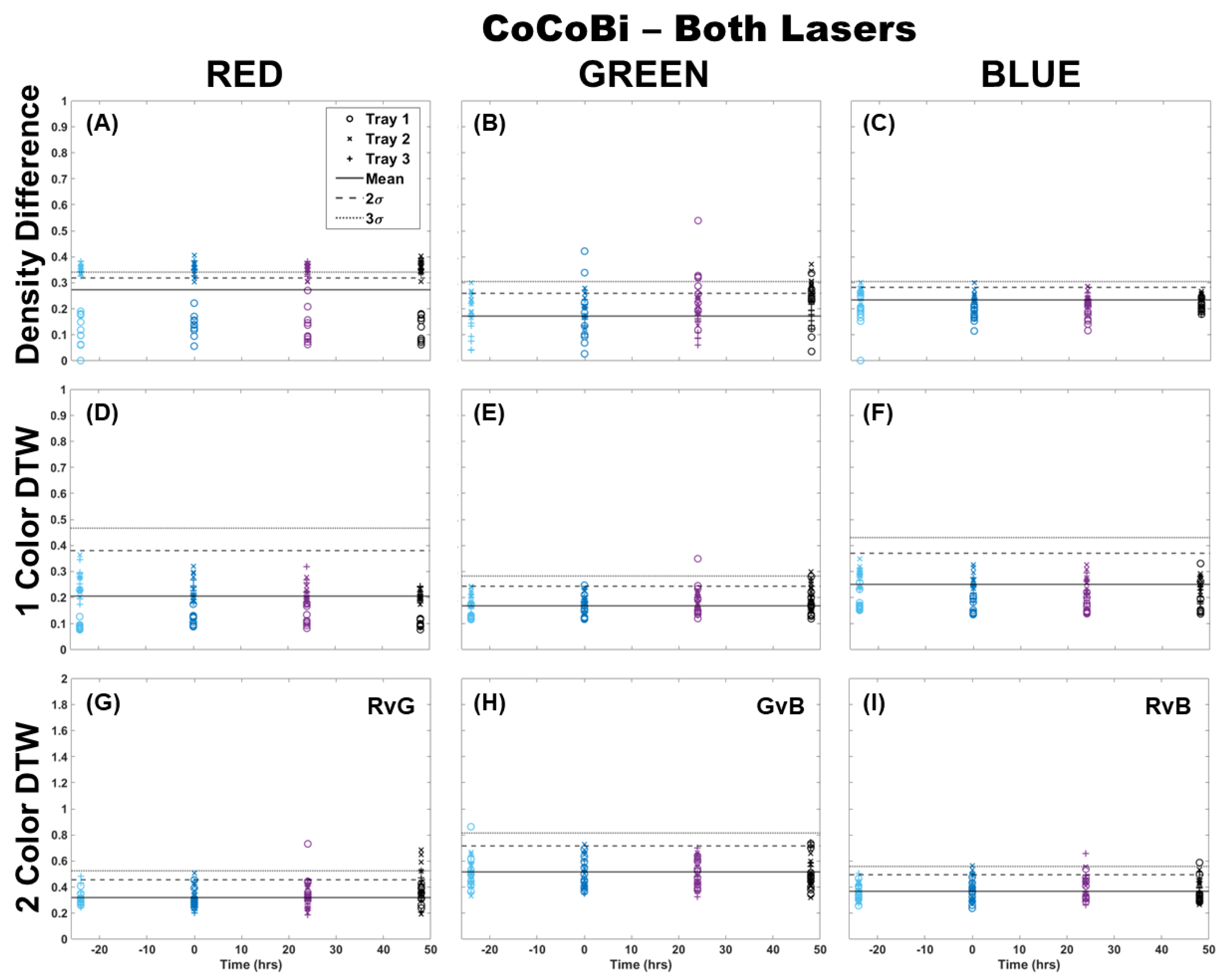
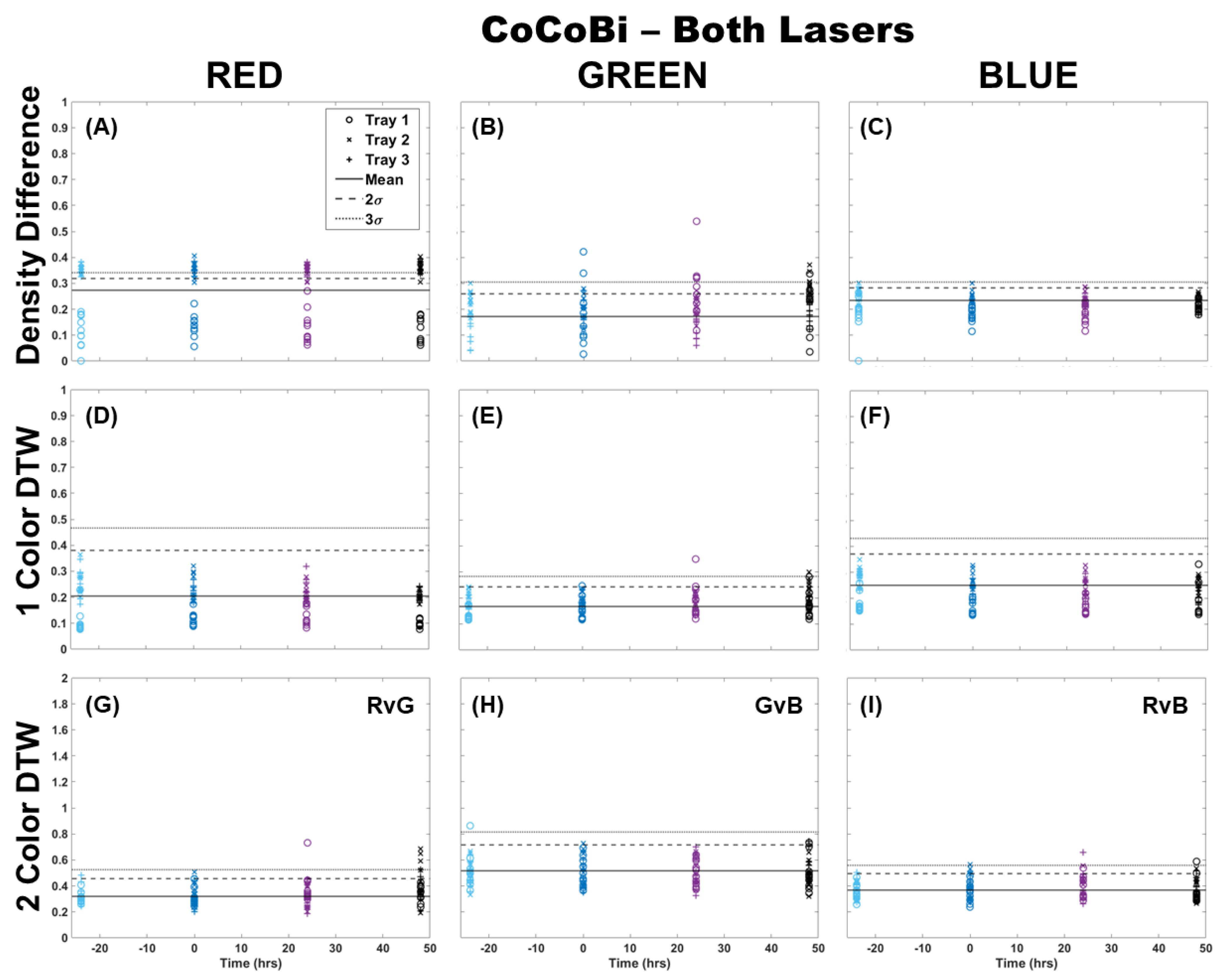

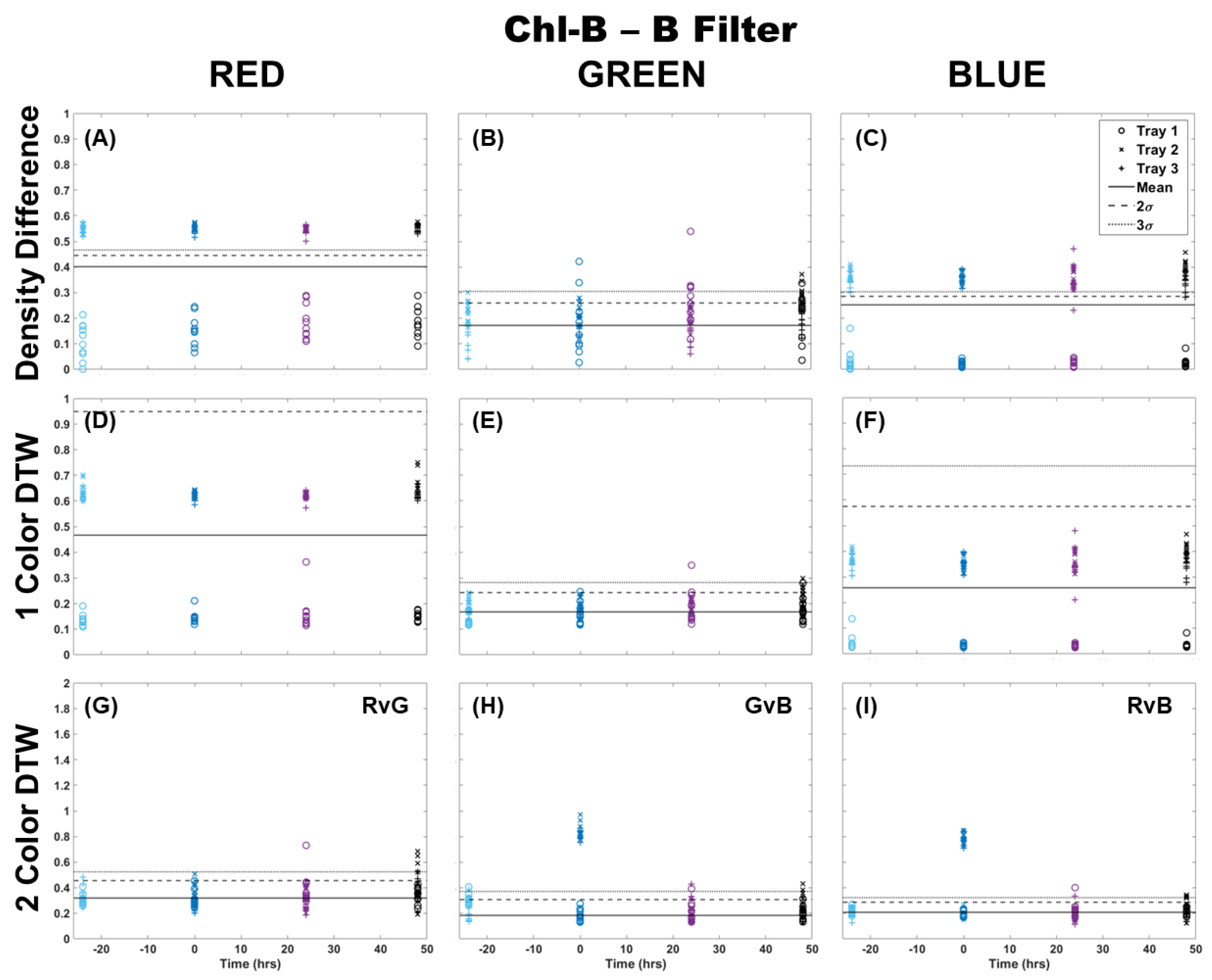
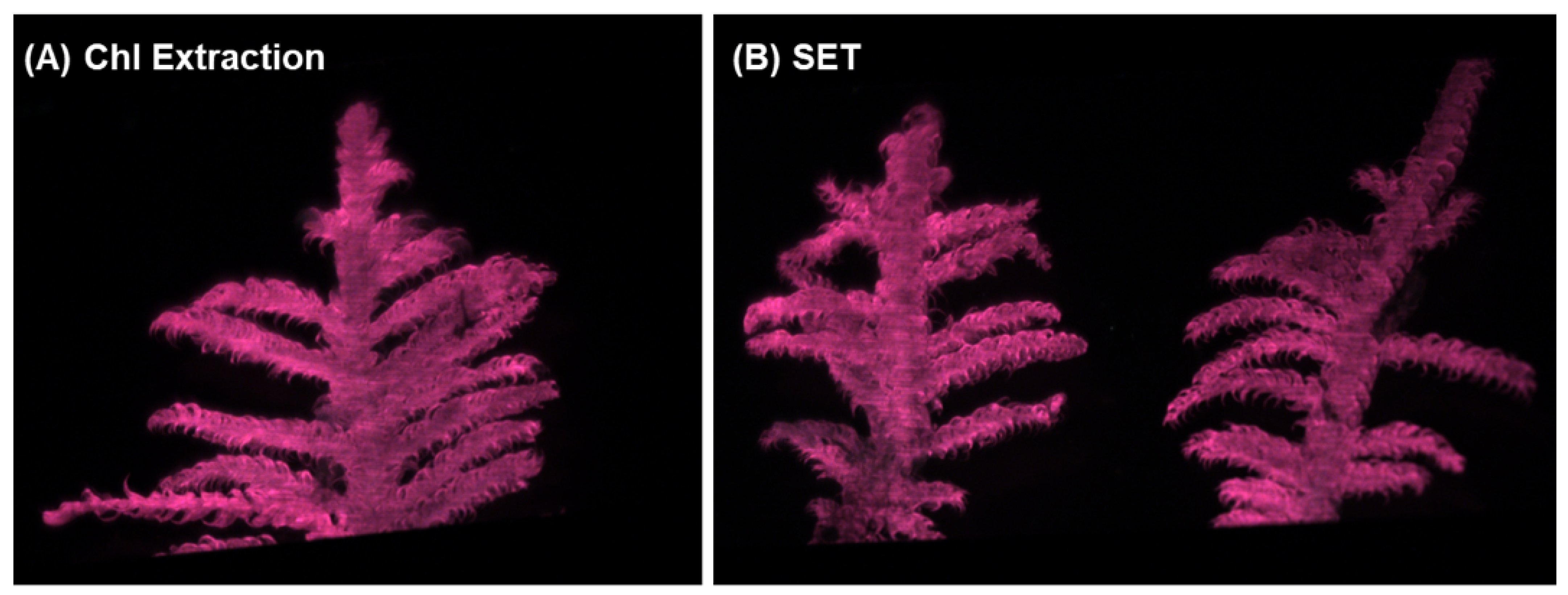
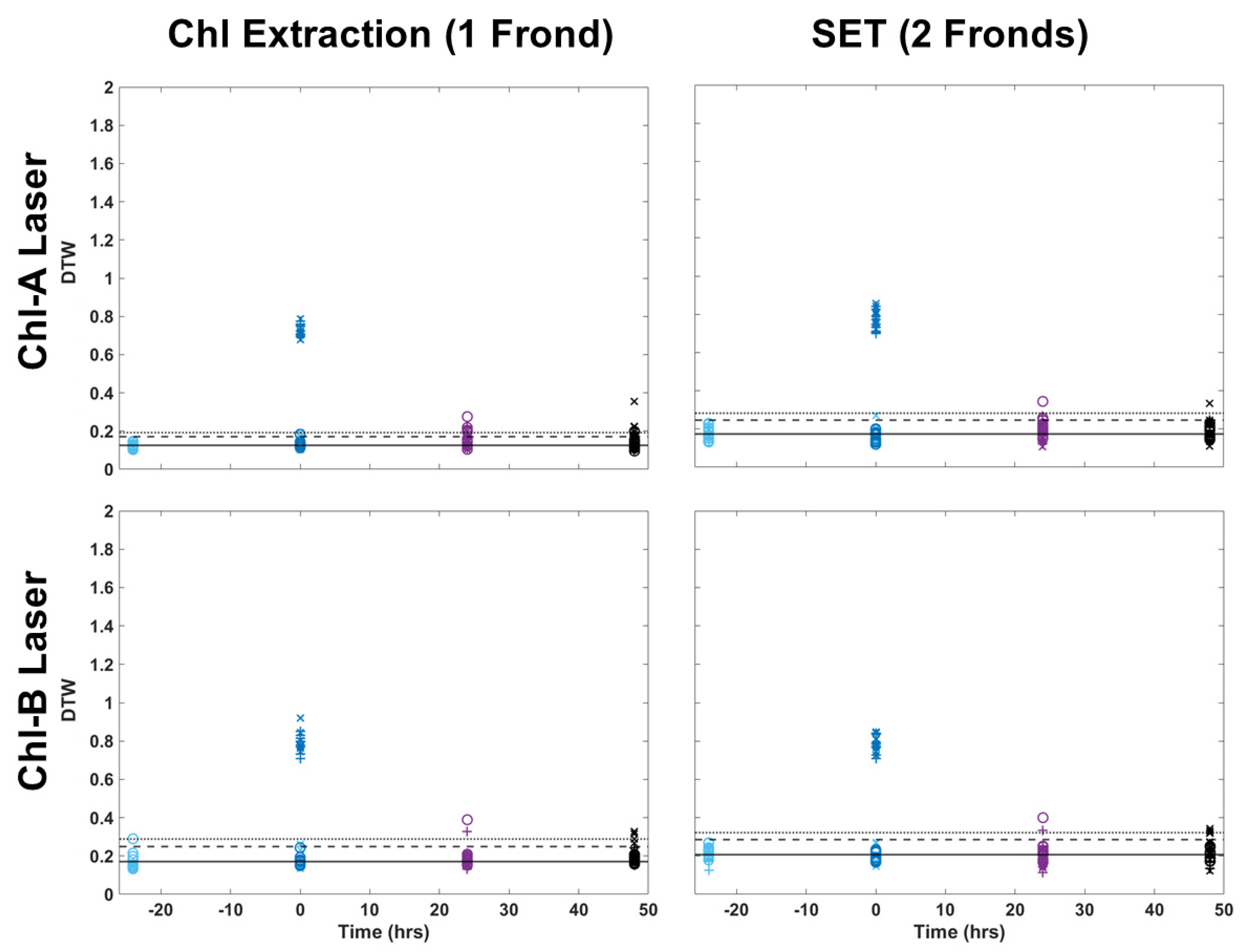
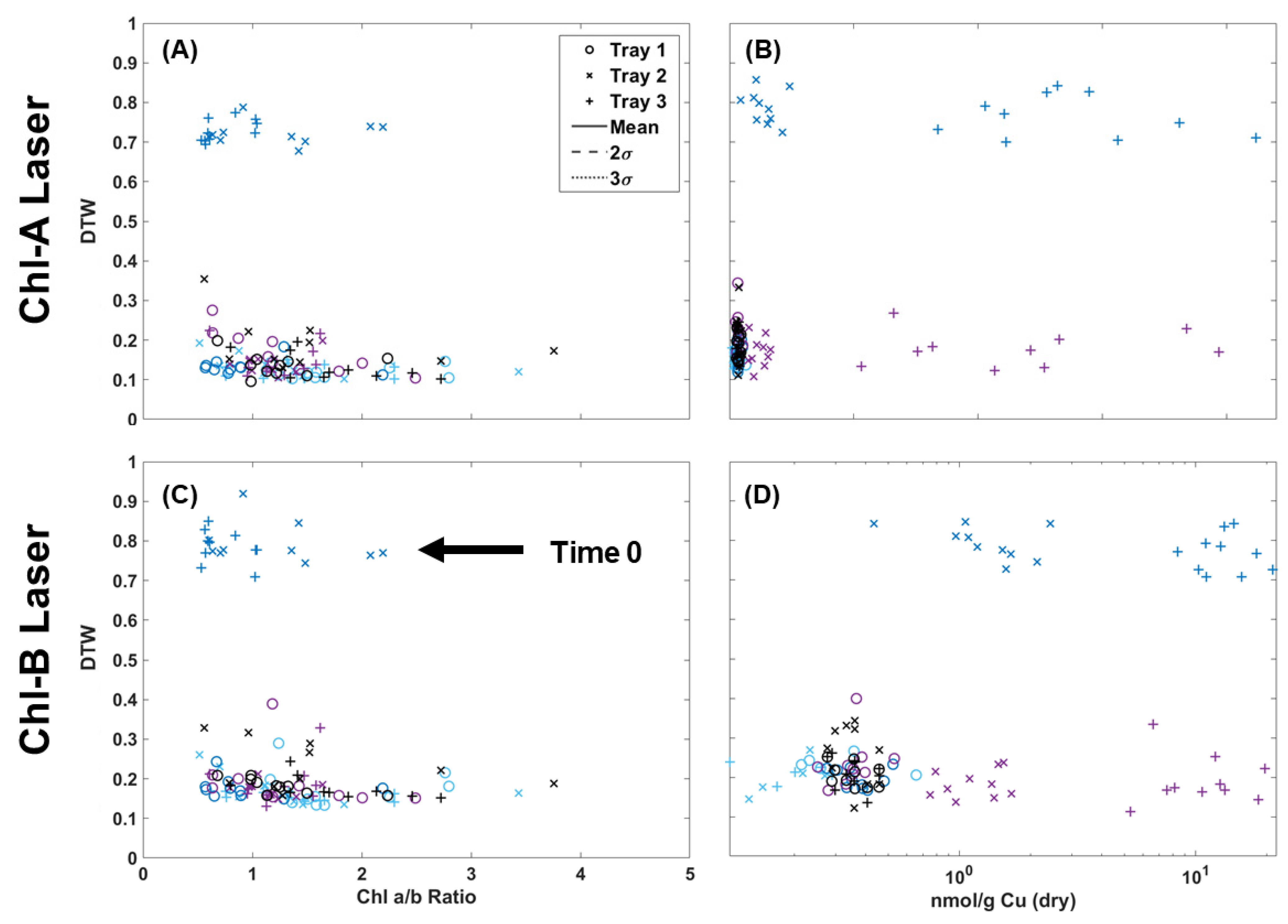
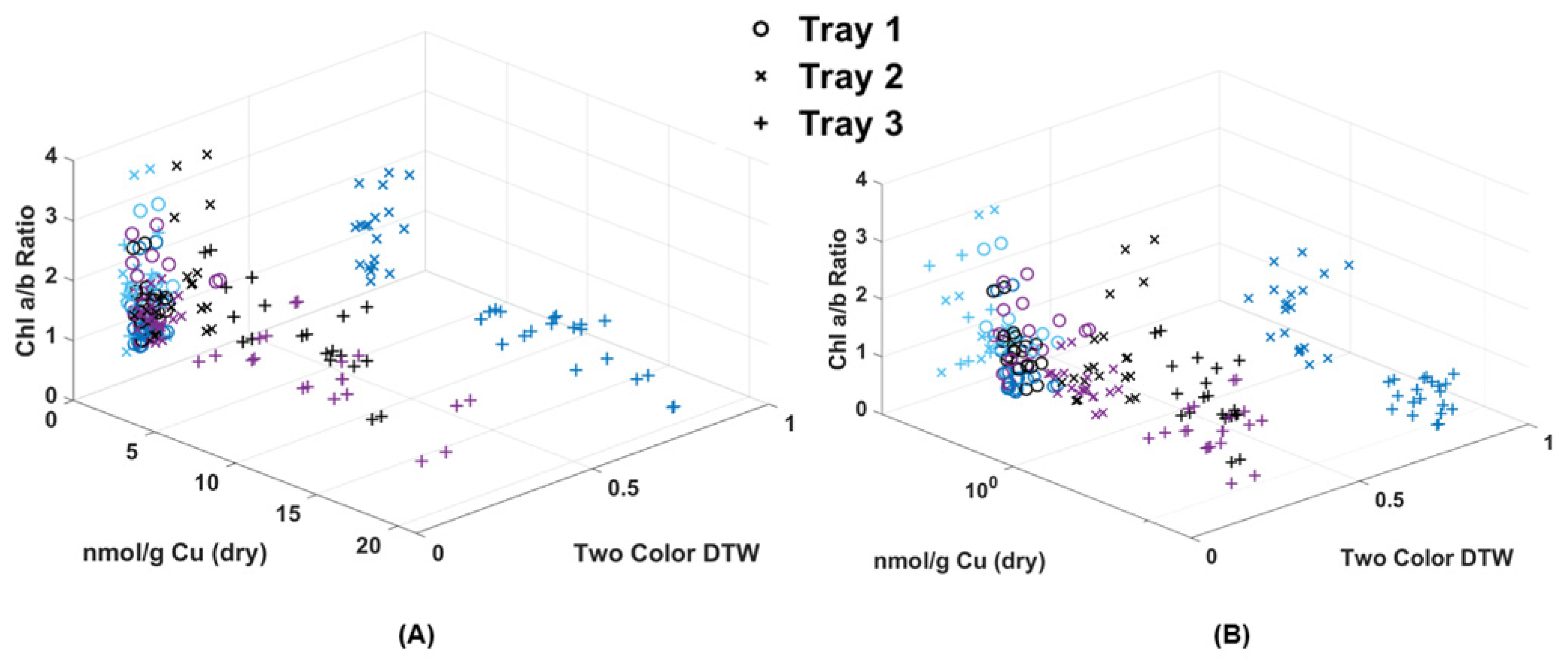


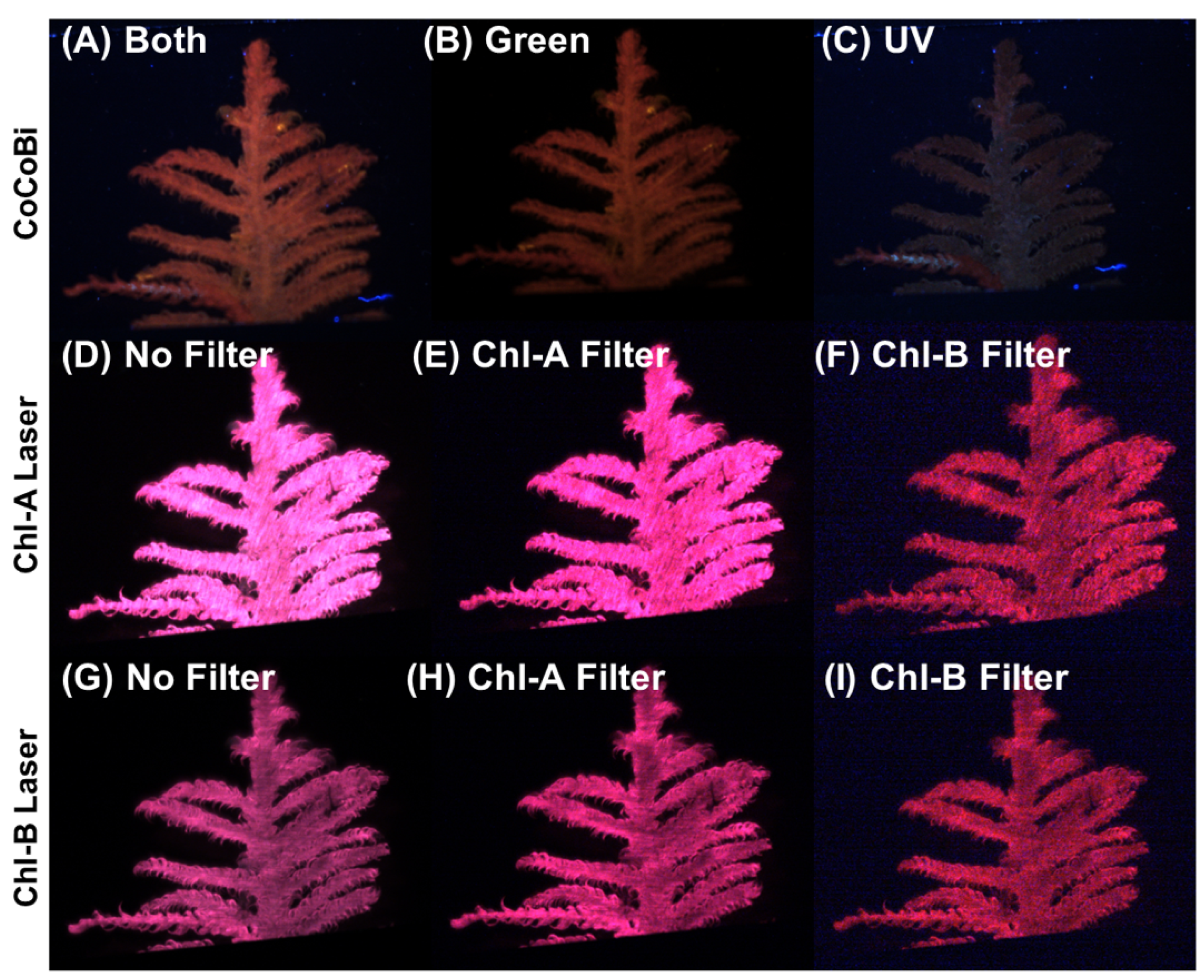
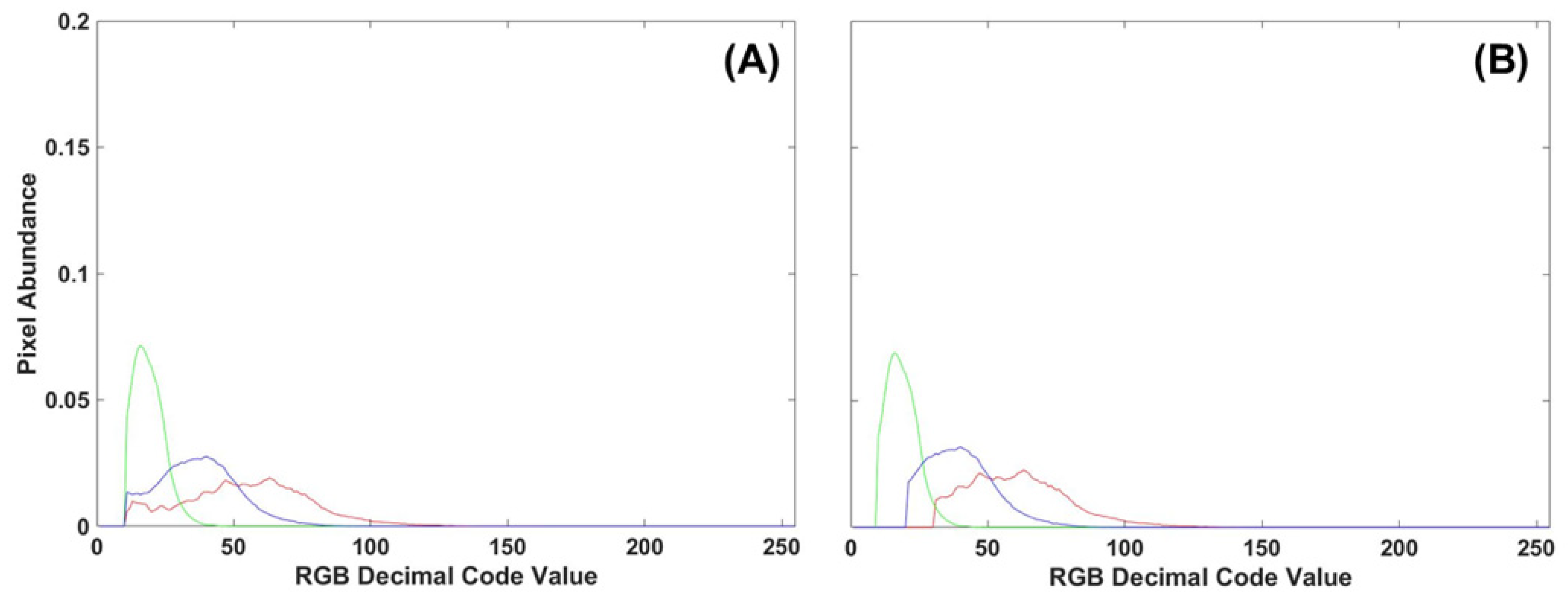
| Tray 1 | Chl-a /mg | Chl-b /mg | Total Chl/mg | Chl a/b Ratio | Tray 2 | Chl-a /mg | Chl-b /mg | Total Chl/mg | Chl a/b Ratio | Tray 3 | Chl-a /mg | Chl-b /mg | Total Chl/mg | Chl a/b Ratio |
|---|---|---|---|---|---|---|---|---|---|---|---|---|---|---|
| Cont 1 | 4.526 | 1.714 | 6.241 | 1.585 | Cont 1 | 3.121 | 1.204 | 4.324 | 1.463 | Cont 1 | 2.214 | 0.853 | 3.068 | 0.763 |
| Cont 2 | 4.112 | 1.609 | 5.722 | 1.163 | Cont 2 | 4.576 | 1.672 | 6.248 | 1.841 | Cont 2 | 2.738 | 0.974 | 3.712 | 1.102 |
| Cont 3 | 4.662 | 1.806 | 6.468 | 2.797 | Cont 3 | 2.773 | 1.043 | 3.816 | 0.519 | Cont 3 | 5.369 | 2.025 | 7.395 | 2.299 |
| Cont 4 | 3.250 | 1.193 | 4.443 | 1.574 | Cont 4 | 7.293 | 2.751 | 10.044 | 3.432 | Cont 4 | 5.131 | 1.920 | 7.050 | 1.473 |
| Cont 5 | 3.355 | 1.319 | 4.674 | 1.364 | Cont 5 | 2.934 | 1.123 | 4.058 | 1.104 | Cont 5 | 3.711 | 1.403 | 5.115 | 1.659 |
| Cont 6 | 2.525 | 1.028 | 3.552 | 1.505 | Cont 6 | 3.998 | 1.488 | 5.486 | 1.118 | Cont 6 | 9.147 | 3.505 | 12.652 | 2.295 |
| Cont 7 | 4.226 | 1.615 | 5.841 | 2.763 | Cont 7 | 3.174 | 1.183 | 4.357 | 0.703 | Cont 7 | 2.278 | 0.882 | 3.160 | 1.330 |
| Cont 8 | 5.012 | 1.928 | 6.940 | 1.659 | Cont 8 | 4.185 | 1.608 | 5.793 | 0.875 | Cont 8 | 3.920 | 1.601 | 5.521 | 1.314 |
| Cont 9 | 4.484 | 1.770 | 6.253 | 1.240 | Cont 9 | 3.907 | 1.453 | 5.360 | 1.381 | Cont 9 | 2.705 | 0.974 | 3.679 | 1.478 |
| Cont 10 | 4.434 | 1.711 | 6.146 | 2.255 | Cont 10 | 7.278 | 2.735 | 10.014 | 5.027 | Cont 10 | 1.870 | 0.680 | 2.549 | 0.755 |
| T0-1 | 1.206 | 0.476 | 1.682 | 0.780 | T0-1 | 2.273 | 0.926 | 3.199 | 0.638 | T0-1 | 1.836 | 0.830 | 2.665 | 1.030 |
| T0-2 | 2.477 | 0.930 | 3.407 | 0.652 | T0-2 | 1.707 | 0.701 | 2.408 | 0.606 | T0-2 | 1.615 | 0.650 | 2.265 | 0.574 |
| T0-3 | 3.395 | 1.268 | 4.663 | 0.673 | T0-3 | 3.953 | 1.614 | 5.567 | 0.710 | T0-3 | 2.533 | 1.016 | 3.549 | 0.598 |
| T0-4 | 3.682 | 1.641 | 5.324 | 0.896 | T0-4 | 4.240 | 1.725 | 5.966 | 2.081 | T0-4 | 2.111 | 0.859 | 2.970 | 0.842 |
| T0-5 | 2.219 | 1.177 | 3.396 | 0.798 | T0-5 | 5.225 | 2.129 | 7.354 | 2.191 | T0-5 | 3.441 | 1.344 | 4.785 | 1.042 |
| T0-6 | 1.689 | 0.619 | 2.308 | 0.577 | T0-6 | 5.779 | 2.248 | 8.027 | 0.918 | T0-6 | 4.022 | 1.509 | 5.531 | 1.026 |
| T0-7 | 3.561 | 1.435 | 4.996 | 1.288 | T0-7 | 2.881 | 1.140 | 4.021 | 0.735 | T0-7 | 1.754 | 0.628 | 2.382 | 0.610 |
| T0-8 | 2.339 | 0.943 | 3.282 | 0.889 | T0-8 | 2.877 | 1.227 | 4.104 | 1.426 | T0-8 | 2.915 | 1.177 | 4.092 | 0.564 |
| T0-9 | 1.809 | 0.731 | 2.540 | 0.570 | T0-9 | 3.632 | 1.554 | 5.186 | 1.359 | T0-9 | 1.810 | 0.698 | 2.508 | 0.590 |
| T0-10 | 3.429 | 1.351 | 4.780 | 2.192 | T0-10 | 2.849 | 1.245 | 4.095 | 1.482 | T0-10 | 1.999 | 0.745 | 2.744 | 0.533 |
| T24-1 | 2.640 | 0.992 | 3.632 | 1.792 | T24-1 | 3.702 | 1.354 | 5.056 | 1.642 | T24-1 | 3.520 | 1.385 | 4.905 | 1.474 |
| T24-2 | 3.615 | 1.332 | 4.947 | 1.144 | T24-2 | 2.681 | 0.998 | 3.679 | 1.238 | T24-2 | 5.275 | 1.926 | 7.201 | 1.621 |
| T24-3 | 3.551 | 1.389 | 4.940 | 0.635 | T24-3 | 2.152 | 0.784 | 2.936 | 0.995 | T24-3 | 1.799 | 0.742 | 2.542 | 0.607 |
| T24-4 | 2.755 | 1.065 | 3.819 | 0.871 | T24-4 | 2.626 | 1.043 | 3.669 | 1.054 | T24-4 | 2.161 | 0.792 | 2.952 | 0.964 |
| T24-5 | 2.348 | 0.892 | 3.240 | 2.005 | T24-5 | 2.702 | 0.981 | 3.682 | 1.399 | T24-5 | 2.777 | 1.056 | 3.833 | 1.129 |
| T24-6 | 4.465 | 1.756 | 6.221 | 0.636 | T24-6 | 2.525 | 0.945 | 3.470 | 0.794 | T24-6 | 1.498 | 0.549 | 2.047 | 1.581 |
| T24-7 | 4.559 | 1.709 | 6.268 | 1.427 | T24-7 | 3.311 | 1.188 | 4.499 | 0.971 | T24-7 | 1.677 | 0.596 | 2.272 | 1.294 |
| T24-8 | 6.657 | 2.401 | 9.059 | 2.490 | T24-8 | 4.602 | 1.652 | 6.254 | 1.174 | T24-8 | 1.712 | 0.668 | 2.380 | 0.954 |
| T24-9 | 1.710 | 0.632 | 2.341 | 1.183 | T24-9 | 4.462 | 1.729 | 6.191 | 0.977 | T24-9 | 1.812 | 0.606 | 2.419 | 1.128 |
| T24-10 | 3.957 | 1.480 | 5.437 | 1.186 | T24-10 | 5.013 | 1.936 | 6.949 | 1.191 | T24-10 | 1.770 | 0.623 | 2.393 | 1.556 |
| T48-1 | 3.472 | 1.248 | 4.721 | 1.042 | T48-1 | 2.278 | 0.842 | 3.120 | 0.790 | T48-1 | 3.160 | 1.087 | 4.246 | 2.463 |
| T48-2 | 3.517 | 1.366 | 4.883 | 1.219 | T48-2 | 3.055 | 1.088 | 4.143 | 1.279 | T48-2 | 2.013 | 0.680 | 2.693 | 1.346 |
| T48-3 | 2.692 | 1.003 | 3.696 | 1.251 | T48-3 | 4.375 | 1.672 | 6.047 | 0.561 | T48-3 | 6.490 | 2.480 | 8.970 | 1.415 |
| T48-4 | 1.996 | 0.752 | 2.748 | 0.987 | T48-4 | 8.229 | 3.007 | 11.236 | 3.755 | T48-4 | 3.291 | 1.265 | 4.556 | 1.702 |
| T48-5 | 2.413 | 0.868 | 3.281 | 2.236 | T48-5 | 3.986 | 1.475 | 5.461 | 1.201 | T48-5 | 2.946 | 1.123 | 4.070 | 1.347 |
| T48-6 | 2.091 | 0.762 | 2.853 | 0.985 | T48-6 | 3.117 | 1.206 | 4.323 | 1.434 | T48-6 | 2.559 | 0.867 | 3.426 | 2.726 |
| T48-7 | 2.889 | 1.005 | 3.894 | 1.326 | T48-7 | 3.473 | 1.269 | 4.742 | 1.526 | T48-7 | 6.746 | 2.636 | 9.383 | 1.876 |
| T48-8 | 3.817 | 1.434 | 5.251 | 1.499 | T48-8 | 4.453 | 1.666 | 6.119 | 0.964 | T48-8 | 3.498 | 1.307 | 4.806 | 0.801 |
| T48-9 | 2.055 | 0.783 | 2.839 | 1.133 | T48-9 | 3.218 | 1.168 | 4.386 | 2.727 | T48-9 | 2.642 | 1.082 | 3.724 | 2.134 |
| T48-10 | 0.733 | 0.262 | 0.995 | 0.681 | T48-10 | 5.311 | 1.919 | 7.231 | 1.523 | T48-10 | 1.785 | 0.644 | 2.429 | 1.651 |
| Tray 1 | ww | dw | Tray 2 | ww | dw | Tray 3 | ww | dw |
|---|---|---|---|---|---|---|---|---|
| Control 1 | 0.135 | 0.657 | Control 1 | 0.073 | 0.270 | Control 1 | 0.027 | 0.169 |
| Control 2 | 0.047 | 0.232 | Control 2 | 0.028 | 0.147 | Control 2 | 0.043 | 0.261 |
| Control 3 | 0.049 | 0.215 | Control 3 | 0.023 | 0.129 | Control 3 | 0.040 | 0.107 |
| Control 4 | 0.058 | 0.258 | Control 4 | 0.037 | 0.218 | Control 4 | 0.042 | 0.290 |
| Control 5 | 0.050 | 0.358 | Control 5 | 0.034 | 0.233 | Control 5 | 0.030 | 0.201 |
| Time 0-1 | 0.090 | 0.304 | Time 0-1 | 0.210 | 1.524 | Time 0-1 | 2.124 | 14.470 |
| Time 0-2 | 0.113 | 0.409 | Time 0-2 | 0.261 | 2.136 | Time 0-2 | 2.258 | 11.109 |
| Time 0-3 | 0.126 | 0.524 | Time 0-3 | 0.099 | 0.965 | Time 0-3 | 1.351 | 11.039 |
| Time 0-4 | 0.079 | 0.352 | Time 0-4 | 0.176 | 1.061 | Time 0-4 | 2.106 | 13.178 |
| Time 0-5 | 0.098 | 0.387 | Time 0-5 | 0.286 | 2.420 | Time 0-5 | 1.593 | 12.760 |
| Time 0-6 | 0.084 | 0.390 | Time 0-6 | 0.069 | 0.434 | Time 0-6 | 1.613 | 10.272 |
| Time 0-7 | 0.060 | 0.346 | Time 0-7 | 0.180 | 1.648 | Time 0-7 | 2.065 | 15.628 |
| Time 0-8 | 0.185 | 0.480 | Time 0-8 | 0.133 | 1.094 | Time 0-8 | 0.989 | 8.377 |
| Time 0-9 | 0.059 | 0.334 | Time 0-9 | 0.121 | 1.195 | Time 0-9 | 2.396 | 18.085 |
| Time 0-10 | 0.108 | 0.275 | Time 0-10 | 0.195 | 1.578 | Time 0-10 | 2.426 | 21.176 |
| Time 24-1 | 0.135 | 0.531 | Time 24-1 | 0.173 | 0.790 | Time 24-1 | 2.047 | 12.101 |
| Time 24-2 | 0.083 | 0.387 | Time 24-2 | 0.184 | 0.891 | Time 24-2 | 0.894 | 6.601 |
| Time 24-3 | 0.068 | 0.331 | Time 24-3 | 0.122 | 0.965 | Time 24-3 | 3.789 | 18.376 |
| Time 24-4 | 0.059 | 0.337 | Time 24-4 | 0.207 | 1.541 | Time 24-4 | 1.480 | 10.655 |
| Time 24-5 | 0.095 | 0.355 | Time 24-5 | 0.158 | 1.458 | Time 24-5 | 1.495 | 7.566 |
| Time 24-6 | 0.032 | 0.251 | Time 24-6 | 0.426 | 1.659 | Time 24-6 | 2.727 | 19.670 |
| Time 24-7 | 0.063 | 0.279 | Time 24-7 | 0.199 | 1.103 | Time 24-7 | 2.184 | 12.659 |
| Time 24-8 | 0.067 | 0.356 | Time 24-8 | 0.236 | 1.400 | Time 24-8 | 0.696 | 5.298 |
| Time 24-9 | 0.050 | 0.367 | Time 24-9 | 0.170 | 1.370 | Time 24-9 | 2.138 | 13.261 |
| Time 24-10 | 0.088 | 0.399 | Time 24-10 | 0.101 | 0.753 | Time 24-10 | 1.254 | 8.152 |
| Time 48-1 | 0.091 | 0.457 | Time 48-1 | 0.181 | 1.022 | Time 48-1 | 2.285 | 13.269 |
| Time 48-2 | 0.101 | 0.358 | Time 48-2 | 0.233 | 1.148 | Time 48-2 | 0.983 | 6.900 |
| Time 48-3 | 0.058 | 0.361 | Time 48-3 | 0.188 | 1.114 | Time 48-3 | 2.035 | 11.327 |
| Time 48-4 | 0.056 | 0.276 | Time 48-4 | 0.440 | 2.323 | Time 48-4 | 1.148 | 6.357 |
| Time 48-5 | 0.089 | 0.289 | Time 48-5 | 0.214 | 1.199 | Time 48-5 | 1.719 | 10.314 |
| Time 48-6 | 0.127 | 0.408 | Time 48-6 | 0.208 | 1.254 | Time 48-6 | 1.722 | 5.176 |
| Time 48-7 | 0.064 | 0.297 | Time 48-7 | 0.257 | 0.760 | Time 48-7 | 2.124 | 10.785 |
| Time 48-8 | 0.063 | 0.333 | Time 48-8 | 0.242 | 1.107 | Time 48-8 | 1.814 | 14.474 |
| Time 48-9 | 0.098 | 0.361 | Time 48-9 | 0.249 | 1.470 | Time 48-9 | 0.755 | 5.778 |
| Time 48-10 | 0.124 | 0.457 | Time 48-10 | 0.339 | 1.497 | Time 48-10 | 1.886 | 13.694 |
| Laser | Filter |
|---|---|
| CoCoBi—532 nm and 355 nm | None |
| CoCoBi—532 nm | 355 nm |
| CoCoBi—355 nm | 532 nm |
| Chl-SL—A 445 nm | None |
| Chl-SL—A 445 nm | 650—chl-b |
| Chl-SL—A 445 nm | 670—chl-a |
| Chl-SL—B 462 nm | None |
| Chl-SL—B 462 nm | 650—chl-b |
| Chl-SL—B 462 nm | 670—chl-a |
Disclaimer/Publisher’s Note: The statements, opinions and data contained in all publications are solely those of the individual author(s) and contributor(s) and not of MDPI and/or the editor(s). MDPI and/or the editor(s) disclaim responsibility for any injury to people or property resulting from any ideas, methods, instructions or products referred to in the content. |
© 2024 by the authors. Licensee MDPI, Basel, Switzerland. This article is an open access article distributed under the terms and conditions of the Creative Commons Attribution (CC BY) license (https://creativecommons.org/licenses/by/4.0/).
Share and Cite
Truax, K.; Dulai, H.; Misra, A.; Kuhne, W.; Smith, C.; Bongolan-Aquino, C. Applications of LIF to Document Natural Variability of Chlorophyll Content and Cu Uptake in Moss. Plants 2024, 13, 2031. https://doi.org/10.3390/plants13152031
Truax K, Dulai H, Misra A, Kuhne W, Smith C, Bongolan-Aquino C. Applications of LIF to Document Natural Variability of Chlorophyll Content and Cu Uptake in Moss. Plants. 2024; 13(15):2031. https://doi.org/10.3390/plants13152031
Chicago/Turabian StyleTruax, Kelly, Henrietta Dulai, Anupam Misra, Wendy Kuhne, Celia Smith, and Ciara Bongolan-Aquino. 2024. "Applications of LIF to Document Natural Variability of Chlorophyll Content and Cu Uptake in Moss" Plants 13, no. 15: 2031. https://doi.org/10.3390/plants13152031
APA StyleTruax, K., Dulai, H., Misra, A., Kuhne, W., Smith, C., & Bongolan-Aquino, C. (2024). Applications of LIF to Document Natural Variability of Chlorophyll Content and Cu Uptake in Moss. Plants, 13(15), 2031. https://doi.org/10.3390/plants13152031






